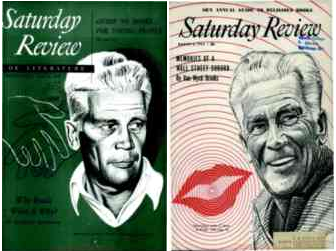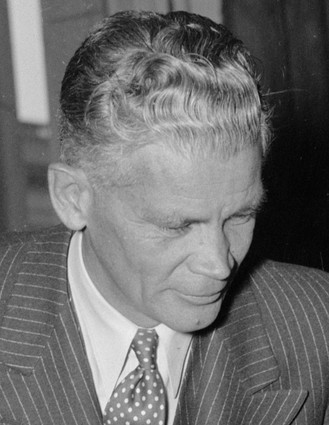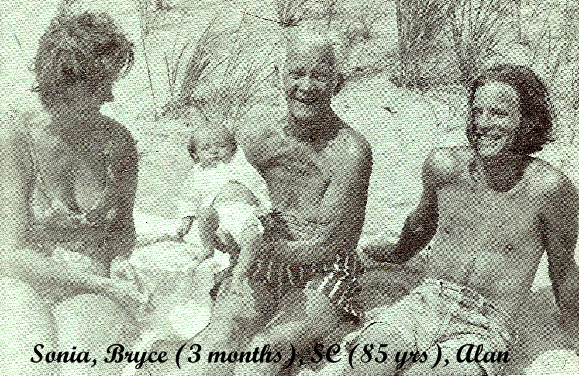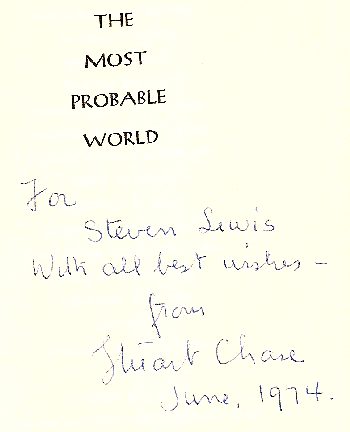
Stuart Chase - A Biography
Written 2012 by Steven Lewis
Stuart Chase (1888-1985) was an American certified public accountant and author of more than 30 non-fiction books that deplored waste ("The Tragedy of Waste," 1925), promoted consumer education ("Your Money's Worth," 1927), provided a label and an agenda for the administration of Franklin Delano Roosevelt ("A New Deal," 1932), popularized Alfred Korzybski's General Semantics ("The Tyranny of Words," 1938) and Keynesian economics ("Where's the Money Coming From," 1943 and "Money to Grow On," 1964) and promoted the funding of research in the social and behavioral sciences ("The Proper Study of Mankind," 1948).
Chase was born March 8, 1888, in Somersworth, New Hampshire, to Harvey Stuart Chase (1861-1946) and Aaronette Rowe Chase. His father was an engineer and an accountant. Chase married twice: Margaret Hatfield (1887-1955), in 1914, divorced 1929, and Marian Tyler (1896-1989), in 1930. He had two children with his first wife: Robert (1916-1986) and Sonia (1920-2017). Chase died November 16, 1985, at his home in Redding, Connecticut, a rural community where he had lived in a renovated barn since 1930. His cremated remains were buried in Umpawaug cemetery. Chase served on the town's planning commission from 1956 until his death.
Chase was educated at MIT and Harvard, where he graduated with honors in 1910. After graduation he worked for his father's accounting firm in Boston and became a certified public accountant. Chase aspired to be much more than a 'bean-counter,' especially after reading Progress and Poverty by Henry George in 1911. The book set Chase on a radical course. He joined the Boston club of the Fabian socialist movement, which advocated government intervention to ensure more equitable distribution of wealth. He campaigned for causes such as voting rights for women, birth control and a single tax based on land value. Chase and his first wife, Margaret, also a Fabian socialist, spent their honeymoon in 1914 posing as a homeless couple in Rochester, New York. The resulting 'baby' was a book published in 1916, A Honeymoon Experiment, that recounted their unsuccessful attempts to find work at a decent wage. When America teetered on the brink of entering what would eventually be called the first world war, Chase marched to the Capitol in Washington in a futile protest.
Chase followed the Bolshevik revolution in Russia and studied and rejected Marxism as outdated. More influential were the writings of Thorstein Veblen (1857-1929), a social economist, who prophesied the rule of engineers and technicians in a mechanized, planned economy and imparted to Chase a higher purpose for 'bean-counters.' In 1917 he left his father's employment to put these ideas into practice in government. He became an auditor for the Federal Trade Commission, where he investigated the meat packing and dairy industries. His zealous questioning of the accounting practices of meat packers drew the wrath of the industry and their spokesmen in Congress. He was abruptly dismissed from government service in December 1920. The stated reason was "lack of funds." (Vangermeersch, 2005, p26)
With a wife and two kids to support, Chase began a career of private consulting and writing that included a stint from 1922-1939 as director of the Labor Bureau, a research organization for labor unions. Chase's economic writings throughout his long career focused on the tragedy of waste in an economy of abundance, a theme derived largely from his reading of Veblen. By "waste" Chase meant idle workers, planned obsolescence, deceptive advertising, unrestrained greed, public squalor and "conspicuous consumption," a phrase invented by Veblen in his most famous work, The Theory of the Leisure Class. Chase sent a copy of his 1925 book, "The Tragedy of Waste," to Veblen, who responded with an invitation to dinner. Chase recounted his dinner with Veblen in his introduction to a 1934 reprint of "Theory of the Leisure Class." Chase's experiences in government during the war, where he observed the success of central planning by the War Industries Board, crystallized into a belief that a modern economy could best serve the public if many of its functions were centrally managed by engineers and other technical specialists for the benefit of the many, not the few. This "technocracy" or "human engineering" movement reached its zenith in the 1930s but persisted throughout the writings of Chase.
While Chase was researching "The Tragedy of Waste" he made the acquaintance of Frederick J. Schlink. The two of them collaborated on his next book, "Your Money's Worth," which became a Book-of-the-Month Club selection and a best-seller. In 1929 Chase and Schlink founded Consumers Research, the first non-profit organization dedicated to testing consumer products and distributing its data to the public in a monthly magazine. Consumers Research was a forerunner of Consumers Union, a copycat non-profit born in 1936.
Chase was part of a delegation of Americans, including future New Dealer Rexford Tugwell, that toured the Soviet Union in the summer of 1927. The trip included interviews with many Soviet leaders, including Leon Trotsky and Joseph Stalin. Chase and Tugwell contributed chapters to the group's report, Soviet Russia in the Second Decade, that was published in 1928. Chase wrote the chapter on Soviet central planning where he noted that the Russian people had no history of democracy. The 1917 Russian Revolution had replaced a dictatorship of the czars with another dictatorship -- ostensibly of the "proletariat," with Comrade Stalin their current leading spokesman. But could the central planning of the Soviet economy offer any insights for democratic societies? According to Chase, "We will have to give the Gosplan [State Planning Commission] another five years before we can definitely say if this courageous and unprecedented experiment is destined to be a landmark for the economic guidance of other people, or just another memorandum for the waste-paper basket of History." (p 54)
Before their report could be published, however, Stalin began his first round of purges, which included the exile and eventual assassination of Trotsky. The economic reforms of the Russian Revolution would take a backseat to the genocidal rule of a tyrant.
Chase's next book focused on the U.S. economy: Prosperity: Fact or Myth. The book was at the printer when the stock market crashed in October 1929. Chase concluded the book by saying: "Prosperity in any deeper sense awaits the liberation of the engineer. If the owners will not get off his back -- and why should they; they pay him little enough and he fills their safe deposit boxes? -- I, for one, would not be sorry to see him combine with the wayfaring man to lift them off. A complicated technical structure should be run by engineers, not hucksters. But the technician is the modern Prometheus in chains." (p 188)
The crash of the stock market heralded the end of the Roaring Twenties and the onset of the Great Depression, which would see a quarter of Americans unable to find work. Noting the bread lines outside of his New York apartment and the ideological inertia of the Federal government, Chase began writing a book in 1931 that would have a major impact on the 1932 presidential election. The governor of New York, Franklin Delano Roosevelt, was a likely candidate for the presidency. Roosevelt and Chase met for the first time in 1931. Roosevelt would later say that the writings of Chase were responsible for “teaching the American people more about economics than all the others combined.” (Harvard Magazine, Sept.-Oct, 2004)
Chase's book appeared in print in August of 1932. It was titled A New Deal and introduced Americans to the theories of British economist John Maynard Keynes. Chase asserted that mechanization and robotics had solved the problem of production but not the problem of distribution. He advocated greater government intervention in the economy to make the goods flow more freely, reduce waste, level the ups and downs of the business cycle and provide greater security and freedom for workers in an era of increasing specialization.
He recommended a massive public works program funded, if necessary, by Federal government deficit financing to alleviate the unemployment caused by the Great Depression. Chase wrote, "The government is not held to the limitations of the money medium; it is above them, for it makes the money medium. The code for gods is not the code for mortals. The state can double the money supply if it so elects, or it can halve it." (p. 141)
Chase compared free-market ("laissez-faire") capitalism to cancer cells in the human body. The cancer cells go about their frenetic, unregulated exploitation of resources ("anatomical rugged individualism") and eventually destroy the organism. The danger of unregulated capitalism may have been trivial in the low-energy society of Adam Smith (1723-1790) when family farms and "mom-and-pop" businesses were dominant, but the economic landscape was now dominated by huge corporations and monopolies whose size deterred competition and whose 'profit motive' could do serious damage to the public welfare if left unregulated. (p. 5)
A preview of Chase's book called "A New Deal for America" was featured on the cover of the The New Republic magazine during the Democratic National Convention in Chicago in July 1932. The convention nominated Roosevelt for president and in his acceptance speech FDR promised Americans "a new deal" if elected. The title of Chase's book and many of its reforms became part of the Roosevelt revolution: expanded public projects to employ workers, unemployment insurance, minimum wage, old-age pensions, overtime pay, right of workers to organize, child labor laws, banking and securities reforms .... The book also caught the attention of Albert Einstein, who wrote Chase in 1935: "Not often in my life has a book come into my hands with which I could
agree so completely." (Vangermeersch, 2005, p 14).
Chase defended Roosevelt's New Deal programs to stimulate and stabilize the economy through public works and regulations, and served as a consultant to several New Deal agencies. Many years later Chase wrote: "Somebody had to act as a catalyst and connect the idle men with the idle plants. Somebody had to start the idle money moving. This was the historic role of Franklin Roosevelt and his New Deal." (The Most Probable World, p 102.)
Chase's career began another transformation around 1934 when he was introduced to the work of a Polish immigrant, Alfred Korzybski, most likely by a mutual friend, Walter Polakov (1879-1948). Korzybski was a 'fellow traveler' in the human engineering (applied science) movement. His first book, "Manhood of Humanity -- The Science and Art of Human Engineering," was published the same year (1921) as Veblen's The Engineers and the Price System, although Korzybski made no mention of Veblen. The human engineering theme and egalitarian agenda of "Manhood of Humanity" would have been familiar news to Chase. What intrigued him was Korzybski's follow-up text, a difficult 800-page treatise called "Science and Sanity: An Introduction to Non-Aristotelian Systems and General Semantics" that attempted a synthesis of human science-mathematical behavior in a form that could be taught to the masses.
Korzybski contended that humans evaluated more by verbal associations than the underlying non-verbal facts. He compared the effects of words and slogans on humans to Pavlov's experiments on dogs that he trained to salivate at the sound of a bell even in the absence of food. The dogs, Korzybski wrote, identified the ringing of a bell with food. When humans respond to symbols -- whether words or money -- as if they were the underlying realities they "copy animals in their reactions," producing an "unsane" world prone to doctrinal wars and cultural lag. This clarified for Chase how the masses could be so easily manipulated by demagogues and vested interests through the use of labels like "communist," "socialist," "liberal," "fascist," "free enterprise" ... to elicit 'knee-jerk' responses. The public's Pavlovian reactions to the verbiage could effectively block factual evaluation and beneficial change. Not only did Korzybski diagnose the 'disease,' he also prescribed a treatment -- consciousness of abstracting.
Chase later wrote: "I shall never cease to be grateful for the wholesome shock my nervous system received when I first read Korzybski's magnum opus, Science and Sanity. It forced me to realize some of the unconscious assumptions embedded in the language which I as a writer had been calmly accepting." (Power of Words, p 125). The most tangible result was Chase's 1938 bestseller, ''The Tyranny of Words'' in which he became the first popularizer of Korzybski's General Semantics. Chase's encounter with Korzybski had profound effects on both men.
"Tyranny of Words" was published as another war loomed in Europe. In "Tyranny" Chase wrote: "I do not like dictators, especially those styled fascist, but I dislike the facts of modern warfare more. It may be argued -- and is -- that if Hitler gobbles up Russia, the United States will be next.... Hitler has first to deal with Stalin's army, and especially his air force. In the not-too-probable event that he conquered Russia, one suspects that he would have trouble enough trying to sit on the 180,000,000 Slavs who stretch along two continents without being eager to sit on 130,000,0000 Americans occupying a large section of a third continent." (p 340).
In his next book, "The New Western Front," published in 1939, six months before the outbreak of war in Europe, Chase argued that America should re-arm and seek stronger ties with countries in the western hemisphere but keep out of any new European war unless we were directly attacked. Most Americans agreed. Chase's opinion did not change with the fall of France and the onset of the battle for Britain in 1940, although he did support President Roosevelt's efforts to make America the arsenal of democracy. The Japanese attack on Pearl Harbor -- December 7, 1941 -- brought the debate to an end.
The Twentieth Century Fund hired Chase to write a series of 6 books on the topic "When the War Ends." The first of the series appeared in 1942, titled The Road We Are Traveling -- 1914-1942. Here Chase noted the trend in developed countries away from a decentralized economy to more government supervision of the economy. In some countries this trend was democratic -- the United States, Britain and Sweden -- whereas in others it was totalitarian -- Hitler's Germany, Stalin's Russia and Mussolini's Italy (p. 94-97).
Chase's third book in the series, "Where's the Money Coming From," presented a modern view of money as numbers recorded in ledgers that can be created, transferred and extinguished by the Federal government and the banking system.

"Laissez-faire was a healthy revolt from the regimentation and restrictions of feudalism. It took economic power away from prince, noble and landlord and gave it to the hustling merchant and manufacturer. It helped to accumulate capital; aided science and technical progress; paved the way for the economy of abundance. It made for a certain admirable resourcefulness and independence on the part of the fortunate entrepreneur.... On the other hand, the system in practice, if not in theory, never stopped to inquire what an economic system was for. It was each entrepreneur for himself and the devil take the hindmost.... The curse of laissez-faire and its cousin capitalism is that responsibility is removed. Having made his money, the entrepreneur's work is done. Nothing is left save conspicuous consumption, or a thrust at immortality in the creation of a foundation.... The system encouraged through its doctrine of the free market a sublime disregard for the worker. Labor was frankly a commodity to be purchased, like pig iron, coal and fertilizer, at the lowest possible market rate. That rate, until the rise of social legislation and the trade union, was an amount just sufficient to keep breath in the worker's body.... Laissez-faire, in the text-books and copy-books of its apologists, exalted the worst side of human nature -- greed and acquisitiveness. What had hitherto been called a vice, and what you and I know is a vice, was rationalized into a virtue. Money became a moral force, and the whole Western world was forced to substitute pecuniary standards for human ones. The balance sheet supplanted the Bible -- though savants were not lacking to prove that Jesus was himself a hustling entrepreneur...." (p. 61-63)
Chase suggested society should hold large business owners, including stockholders, to a different standard than owners of personal property:
"Socialists in spreading their propaganda have not always been careful to make the distinction between use property and the commercial property of absentee owners. Their enemies have been quick deliberately to confuse the two.... You own a piano. You can play it or not as you please. You can keep anyone else from playing it. It is use property and the arrangement seems fair enough. You also own a factory employing 500 men. You can work it or not as you please, and keep anyone else from working it. Such is the law. The factory, unlike the piano, is not for your use and pleasure. You may know nothing about its technical operations. When you refuse to operate it, not only your income is cut off, but that of 500 others -- who probably are more dependent on the factory income than are you. Or it may be the only factory in the country making a certain essential preparation for hospitals. When you shut it down, the hospital patients suffer. Perhaps, again, you own only 51 percent of the stock of the factory corporation. The other stockholders desire to keep the factory running, but you order it closed. You have the legal right. Absentee ownership is thus deeply involved with the public interest; factories are not pianos for owners to play upon." (The Economy of Abundance, p177-182)
"When people think of money as gold or silver, they find it hard to see that the unemployed can be put to work. They think of a fixed sum, which, if shared with the unemployed, would impoverish the rest of the community. But modern money is not a fixed sum. It is so dynamic and flexible that it can always be expanded to finance new work or new production if there is any slack in the economy at all." (p56)
Chase worked to dissuade the reader of the popular notion that commercial banks loan out their depositors' money but, in reality, create money as debt.
"The total stock of money can be increased in four ways:
1. By the banks' making new loans to commercial enterprises in excess of loans retired.
2. By the banks' making loans to the government in exchange for government bonds.
3. By the government's creating new dollars through bonds deposited in its own central bank -- the Federal Reserve, in our case.
4. By the government's printing new currency." (p42)
Chase suggested that future Great Depressions could be prevented if we followed the advice of British economist John Maynard Keynes -- lower taxes on consumers, increase government spending on public works and inflate the money supply. In his 1964 book "Money to Grow On," Chase noted that the Kennedy administration successfully used these techniques to stimulate growth. To fund public works and maintain full employment without creating a burdensome Federal debt, Chase suggested the Federal government sell non-interest-bearing, non-maturing "growth certificates" to commercial banks, which they could use as reserves to generate money for loans to the public. A more radical option suggested by Chase was for the Federal government to establish its own "Bank for Growth" to create the funds needed for public works and full employment (p100).
After the War, John Kenneth Galbraith, a graduate of Roosevelt's New Deal, picked up the economics pen of Chase while Chase turned his literary attention to other social issues. Congress was investigating the establishment of a National Science Foundation to support research in the sciences. The social sciences were omitted from the original NSF charter in 1950 because some in Congress believed that "man was not part of nature" and so "could not be studied scientifically" and "all we need are the application of established moral precepts" .... It was in this environment that Chase produced "The Proper Study of Mankind," advertising the value of social and behavioral science research (Lindeman, p. 311). First published in 1948, "The Proper Study of Mankind" became a widely-studied college text that was revised in 1955 and 1962. It was partly to Chase's credit that NSF funding was expanded in 1957 to include the social and behavioral sciences.
Several of Chase's post-War books continued to reflect the influence of Korzybski's General Semantics, including "Roads to Agreement," "Power of Words" and "Guides to Straight Thinking." Each described how naive use and misuse of language can derail progress and understanding. Chase introduced Korzybski at a dinner in New York City in 1948 as one of the three leading "intellectual revolutionaries" of his lifetime. His other choices were Einstein and John Maynard Keynes. Chase's final book, written in his 80th year and published in 1969, was a presentation of Korzybski's work written for young people, "Danger - Men Talking!"
Chase revisted the Soviet Union in 1961. In his 1968 book "The Most Probable World," Chase concluded that the Soviets had gone too far in central planning, letting a rigid central ideology deter local initiative, leading to shortages in food and other consumer goods. He noted a loosening of the central grip on the Soviet economy while open societies were moving slowly toward more centralized oversight. (p 113-115) The trend, Chase noted, in all high-energy societies was to move toward a "mixed economy, a mix in which both private and public sectors are recognized as essential, and are encouraged to supplement one another for maximum production." In the United States, for example, the public sector provides the highways and the private sector provides the cars, whose design is regulated by government to encourage safety and protect the environment. (p 99)

In his twilight years Chase continued to write a weekly column for his local newspaper, the Redding Pilot, and contributed occasional articles to magazines, especially the Bulletin of the Atomic Scientists. Chase suggested we were the last civilization -- a global civilization -- whose survival was threatened by nuclear war, exponential population growth, environmental pollution and depletion of natural resources. These issues-without-borders could not be resolved by countries acting alone, but required international cooperation. He argued that economic growth must give way to stable-state economies. He noted that stable state, or sustainable, economies do not imply stagnation. Growth would continue unabated in knowledge and know-how. It is the wasteful, toxic use of resources that would be restrained. Thus, Stuart Chase had returned to the theme that had launched his public career in the 1920s, the tragedy of waste, but the new justification was survival, not simply efficiency and social justice.
Books by Stuart Chase:

References:
Go to General Semantics Home Page ||| Go to Steven Lewis Home Page